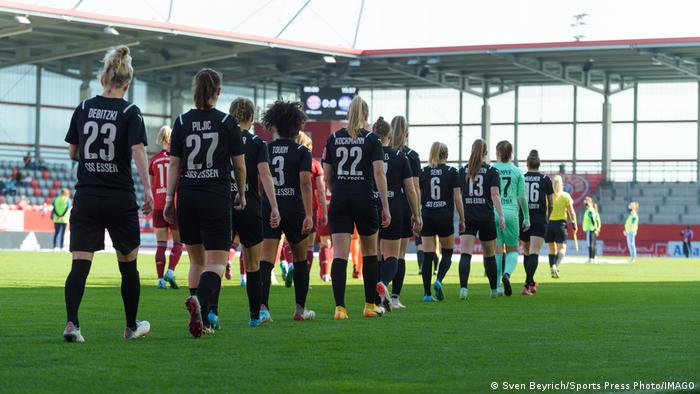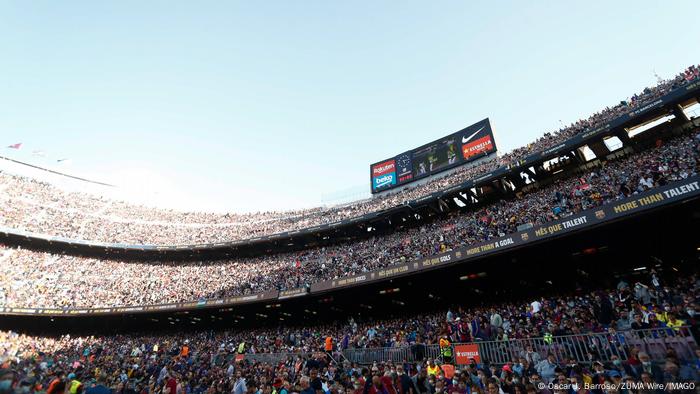When Barcelona host Real Madrid in their Women’s Champions League quarterfinalWednesday, a world-record 85,000 fans are expected to attend.
Were it not for the pandemic still limiting attendance in Spain, that number could have risen to over 100,000 . There’s no doubt that as the women’s game continues to rise in popularity, the Champions League has become the competition of interest for European fans.
But while these one-off big games provide a sizable spike in attendances, the impression it gives to the casual onlooker is misleading. Regular weekly attendances in the biggest European leagues — Germany’s Frauen Bundesliga, England’s Women’s Super League, Spain’s Primera Iberdrola and others — attract attendances only in the hundreds.
Only two teams in Germany, Eintracht Frankfurt and Turbine Potsdam, have an average attendance of over 1,000 this season. By comparison, Wolfsburg and Bayern, the two standout teams in Germany, record average attendance of about 750.

This game between Bayern Frauen and SGS Essen on March 27 attracted just 844 fans — a typical figure in the Women’s Bundesliga.
A Champions League bubble?
The disparity between the huge numbers of fans we will see at Camp Nou and the sparse numbers attending league and cup games across Europe hints at inequalities in the women’s game that rising TV revenues may only exacerbate.
UEFA’s plan has been to play as many games as possible in large arenas, a key part of its strategy to bring the women’s game to new and bigger audiences. While this appears to be working, if participants are returning to domestic attendances below 1,000, it makes the Champions League look like a bubble.
“In this first season of the centralized UEFA Women’s Champions League, we had 13 group-stage matches played in major venues,” Nadine Kessler, UEFA’s chief of women’s football, said in a statement last week.

At least 20,000 more fans will attend the Barcelona vs. Real Madrid women’s match than the recent men’s Clasico in Madrid.
“We are delighted to see this trend continue into the quarterfinals, where seven of the eight clubs will play in their bigger stadium,” Kessler said. “It’s an incredible occasion and a quarterfinal lineup that promises world-class football in world-class class arenas. Big moments like these are what women’s club football needs.”
The strategy of playing box-office games in the biggest stadiums isn’t unique to the Champions League though. The Women’s Super League in England plays the opening game of the season in a big stadium. It’s a strategy that succeeds in generating interest and boosting attendances, even if the effect is short-lived.
Free tickets boost Clasico attendance
If any team can pull off a world-record attendance, it’s Barcelona. The club’s women’s team was established in 1988 and Barca’s long-standing commitment to engaging its fanbase and developing its team has paid off.
The expected attendance at Camp Nou is the result of several factors. Firstly, it’s a Clasico, even if Real Madrid’s women team only came into existence in July 2020. Secondly, Barcelona have made tickets available to its 147,000 club members for free — minus a modest admin fee. And thirdly, increasing levels of in-stadium support is part of a trend across the board in the women’s Champions League.

All 61 games in this season’s Women’s Champions League are being broadcast by DAZN and free on its YouTube channel.
“Barcelona have been very successful at creating a strong identity around its club which extends beyond the senior men’s team in a way that the women’s team have benefited, too,” DW football expert Alina Schwermer said. “They went early with their marketing of the Clasico, but they also have the infrastructure in place.”
Broadcasters see potential in women’s game
The commercial potential of the women’s game has been recognized by the TV broadcasters in recent years, and the Clasico will be shown internationally by DAZN (including for free on its YouTube channel) and BeIN Sports — resulting in more eyes and more revenue.
Though UEFA is seemingly doing what it can to attract more fans to the women’s game, both on TV and in stadiums, there are unanswered questions about whether the association is even interested in ensuring an even playing ground for all clubs.
On the one hand, rising TV revenues will put the demands for equal pay on a stronger footing; on the other, it’s a commercial model that serves the clubs already at the top of the pyramid, rather than supporting teams outside of the existing elite.
The women’s game have been trying to avoid making the same capitalism-driven mistakes that the men’s game has made, resulting in an exclusive band of clubs competing for major honors season after season, with little variation.
“Women’s football offers a chance to see football anew,” Schwermer said. “It could be a possibility to create a different dynamic starting with women’s football that can fuel change. Because if the women’s game simply follows the same path as the men, it will reach the same result with the same problems.”
Edited by James Thorogood.
Women’s Champions League: Record Clasico attendance to only paper over the cracks
Source: Pinoy Pop News

0 Comments